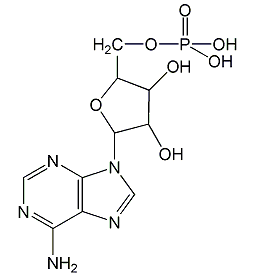
Structural formula
| Business number | 01BR |
|---|---|
| Molecular formula | C10H14N5O7P |
| Molecular weight | 347.22 |
| label |
5′-adenine nucleotide, Adenosine 5′-monophosphate, Adenosine 5′-monophosphate, Adenosine 5-phosphate, Muscle adenylic acid, Adenosine-5′-phosphoric acid, 5′-AMP, 5′-Adenylic acid, Clinically used in disseminated sclerosis |
Numbering system
CAS number:61-19-8
MDL number:MFCD00149360
EINECS number:200-500-0
RTECS number:AU7480500
BRN number:5205540
PubChem ID:None
Physical property data
1. Properties: white crystal. Easy to absorb moisture. Sensitive to light.
2. Density (g/mL, 25/4℃): Undetermined
3. Relative vapor density (g/mL, air=1): Undetermined
4. Melting point (ºC): 183-188
5. Boiling point (ºC, normal pressure): Undetermined
6. Boiling point (ºC, 5.2kPa): Undetermined
7. Refractive index: Undetermined
8. Flash point (ºC): Undetermined
9. Specific rotation (º, c= 2. In 2% sodium hydroxide solution): -47.5
10. Autoignition point or ignition temperature (ºC): Undetermined
11. Vapor pressure (kPa, 25ºC) : Undetermined
12. Saturated vapor pressure (kPa, 60ºC): Undetermined
13. Heat of combustion (KJ/mol): Undetermined
14 . Critical temperature (ºC): Undetermined
15. Critical pressure (KPa): Undetermined
16. Log value of oil-water (octanol/water) partition coefficient: Undetermined
17. Explosion upper limit (%, V/V): Undetermined
18. Explosion lower limit (%, V/V): Undetermined
19. Solubility : Easily soluble in hot water and acetone, slightly soluble in ethanol, insoluble in ether.
Toxicological data
1. Acute toxicity: Mouse abdominal LC50: 4mg/kg 2. Reproductive toxicity: Female rat abdominal TDLo: 2800mg/kg, 7-13 days after conception; Female mouse abdominal TCLo: 2800mg/kg, 7-13 days after conception 3. Mutagenicity: Mutation test system – not other specifiedTEST system: human cells – not otherwise specified: 100umol/L; DNA inhibitionTEST system: rodent – rat liver: 10mmol/L; Mutation test system – not other specifiedTEST system : rodentMaterial – Mouse Liver: 10mmol/L; Mutation Test System – Not Other SpecifiedTEST System: Rodent – Mouse Cells – Not Otherwise Specified: 50umol/L
Ecological data
None yet
Molecular structure data
1. Molar refractive index: 69.90
2. Molar volume (cm3/mol): 149.6
3. Isotonic specific volume (90.2K): 515.5
4. Surface tension (dyne/cm): 140.9
5. Polarizability (10-24cm3): 27.71
Compute chemical data
1. Reference value for hydrophobic parameter calculation (XlogP): None
2. Number of hydrogen bond donors: 5
3. Number of hydrogen bond acceptors: 11
4. Number of rotatable chemical bonds: 4
5. Number of tautomers: 3
6. Topological molecule polar surface area 186
7. Number of heavy atoms: 23
8. Surface charge: 0
9. Complexity: 481
10. Number of isotope atoms: 0
11. Determine the number of atomic stereocenters: 4
12. Uncertain number of atomic stereocenters: 0
13. Determine the number of chemical bond stereocenters: 0
14. Number of uncertain chemical bond stereocenters: 0
15. Number of covalent bond units: 1
Properties and stability
Adenylate is one of the four main single nucleotides that make up the ribonucleic acid of animal cells. It is an energy transfer substance in the body, but it is more stable than adenotriphosphate (ATP). It has significant peripheral vasodilation and antihypertensive effects.
Storage method
Seal and store in a dry place below 0℃ and away from light.
Synthesis method
None yet
Purpose
1. Biochemical research.
2.Clinically used for disseminated sclerosis, porphyria, pruritus, liver disease, and varicose ulcer complications. Compound eye drops mainly composed of adenylate can be used for eye fatigue, central retinitis, corneal surface diseases such as pannus and herpes.

 微信扫一扫打赏
微信扫一扫打赏

